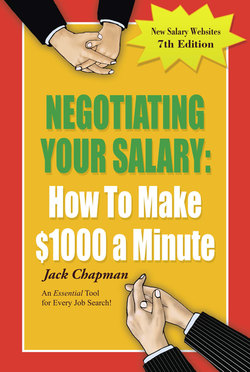Читать книгу Negotiating Your Salary - Jack Chapman - Страница 12
На сайте Литреса книга снята с продажи.
Lightning Round III Salary-Making Rule 3
ОглавлениеWhen you hear the figure or range, follow Salary-Making Rule #3: repeat the figure or top of the range, and then be quiet.
Whether the hiring decision maker is going second and responding to your “Ideal,” or whether he’s speaking first to enter into hiring negotiations, your action is the same: repeat the figure or the top of the range and be quiet.
What Happens When You’re Quiet
Sometimes you’ll get an explanation of why the budget allows only that much. “Times are rough, competition’s tough.” Sometimes you’ll get a raise in those seconds of silence.
Don’t compare the offer with your most recent salary. Instead, use the thirty seconds to compare their offer with your number trio, based on the formula below.
Formula
The numbers for the market value range for you are your own trio of numbers. Ideal, Satisfactory, and No-go, or ISN, Market Values. Here is how to determine this crucial trio: Your Ideal, Satisfactory, and No-go Market Value.
A market value is a picture made up of several pieces: your Objectively Researched Value (ORV$), your extra Individual Value (IV$), what I’ll call your Risk-factor Dollars (Rf$), and benefits and perquisites.
Think of it as a formula in which your personal market value equals the sum of four other values:
ISN Market Values = ORV$ + IV$ + Rf$ + Bennies/Perks.
To fully understand these factors, you need some definitions.
ORV$ (Objectively Researched Value). Objectively researched information from current published data about the going rate; this year’s average earning range for people doing the kind of work you’re considering.
IV$ (Individual Value). A subjective assessment of the strength of your past track record as it applies to this new job or promotion. It puts you somewhere on a scale from entry level to seasoned professional, possibly with a unique competitive advantage. IV$ measures how you stack up individually above or below the competition.
Rf$ (Risk-Factor Dollars). Compensation you are willing to make contingent on your future success, or performance-based compensation.
Benefits and Perks can round out the package.
Calculating the Three Factors (Objectively Researched Value)
Find out in what range people get paid for work similar to yours by consulting published surveys. Make sure you’re comparing apples to apples, that the salary you find matches the responsibilities of the job you expect to be paid for.
You may have a hard time matching your job to a job title. You’ll need to pick one—or two, perhaps—that seem close. Where there are actual job descriptions along with the titles, that can help you select a title most closely related to the level of responsibility.
Once you’re on track with a title and perhaps a job description, begin collecting pay-comparison-analysis information that will coalesce into your objectively researched value (ORV$). The four online “preferred providers” for competitive salary information are
• www.JobStar.org
• www.PayScale.com
• www.Salary.com
• www.GlassDoor.com
• www.Indeed.com
Calculating the Three Factors (Individual Value)
IV$ refers to your assessment of how well (or poorly) you can do the work compared with other candidates’ ability. Are you a cut above average? Well known? Have a special expertise? If so, your added value can add dollars to put your salary in the above-average range.
Calculating the Three Factors, PART III: Rf$
Objectively Researched Value determines a range, and Individual Value a place within that range. Rf$ can take the salary off the chart! Whenever you are willing to negotiate compensation contingent on performance, you add what I call Risk-factor Dollars (Rf$).
Employers’ basic principle in hiring (and conversely, firing) is the Make Me a Buck principle. They bring you aboard because they think your contribution will pay back more money than you cost. Are you willing to bet on it?
If so, then you can add Rf$ to your value.
If you’re just another cog in the wheel, you may not have much solid Rf$ value to work with, but on the other hand, if you expect to make a direct impact on the bottom line, this value could be very high.
Timing: When Should I Calculate my ISN Market Value?
Research and calculate your market value at the very beginning of the job search and interviewing process, but delay actual discussions about the monetary aspect of IV$ and Rf$ components until the employer is serious enough to make you an offer. There’s a fine line here. You do want to ferret out information in the interview to help you determine your IV$ and Rf$ value, but you do not want to discuss them yet as items of compensation.
In the beginning, just reassure the employer you’ll be fine with a “fair market value.” Later, when you’re talking turkey, negotiate those pieces of your market value.
Determining your No-go!
Without a “bottom line,” you may be swayed to accept a salary that’s too low. If you are clear about it before you go into the interview, you are in a solid position. If they don’t reach your “No-go” number, put a “comma” in the negotiations; schedule another round within 24 hours.
Read The Book To Learn
• Library and other printed information as salary research
• Library-research-for-computer-dummies technique
• Person-to-person research: direct-dial resources
• Person-to-person research: word-of-mouth resources
• Screen shots of the several preferred providers
• Several other websites for salary research
• Several examples of IV$
• Several examples of Rf$
